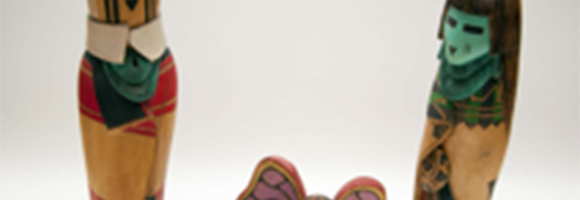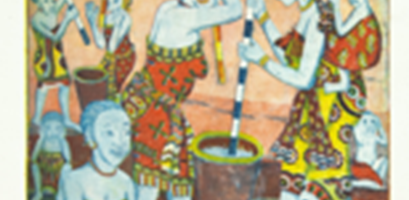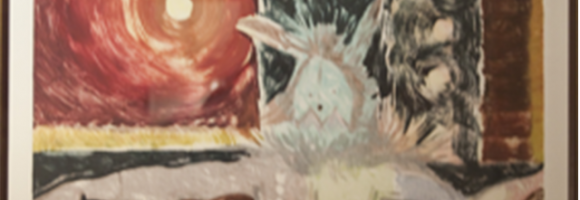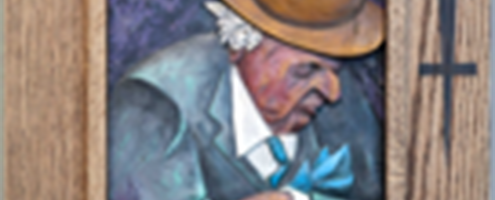Gerry Quotskuyva
I was drawn to these three Kachina dolls when I saw them at an auction house. Although I could not stay for the live auction, I left a bid on these and several others. At the time, I intended to purchase them as gifts. I usually try to find something from the southwest to give to colleagues at Promega at the end of every year.
Luckily, I was the highest bidder on about 40 dolls that day. Because only one other bidder was interested in Kachinas at the auction, I acquired them for much cheaper than I could have imagined.
It wasn’t until after I gave most away that I began to look up the signatures on the bottom of the Kachinas. The most famous of the carvers is Hopi artist Gerry Quotskuyva, who has a gallery in Sedona, Arizona. Naturally I had interest in meeting him and did so during a motorcycle ride to Sedona, Arizona with my wife.
Gerry remembered the dolls well and offered to buy them back. Although he offered me more than I had paid for the group of 40, my better half would not let me sell them that.
I have been in contact with Gerry Quotskuyva and hope to show his carvings, bronzes, paintings and prints at Promega.
People have asked how I come up with exhibition concepts. This is a great example of why it’s difficult to specify. I generally go with what I have in front of me.
Read more about Gerry Quotskuyva.
Robino Ntila
Robino Ntila is an artist based in Tanzania. He works with artists all over Africa, conducting printmaking workshops, mostly with the support of the Ford Foundation. He has taught many artists how to print, helping them market their work in the process.
Robino worked closely with the famous Makonde artist George Lilanga, teaching him the art of printing. Lilanga, one of the few early carvers able to transition from three-dimensional to two-dimensional work, made the transition from carver to visual artist in a movement called Tinga Tinga. His distinct style characterized the start of the movement in Tanzania, one which Ntila continues today, alongside Lilanga’s son.
I met Robino Ntila in Nairobi in 1994. I have more than one hundred Ntila prints, as the artist used to send them to me once a year. Today, Ntila has taken to painting, and thus no longer sends me etchings.
Baje Whitethorne Sr.
These prints are by a group of artists I have become close with since moving to Arizona in 2001, most of which have exhibited work at Promega. All of these artists belong to several organizations comprised of Latino and American Indian artists in the Phoenix area.
I’ve come to find a very rich art scene in Arizona, much as I did living in Kenya years ago. In both places, I became involved with and had the good fortune to work with artists and to exhibit their work.
I have come across great artists all over the world and have somehow managed to end up with a diverse collection of art pieces to remind me of those relationships. By far, the most interesting and valuable aspect of what I do is getting to know unique and fascinating people.
Tom Schlanker
Wood Relief
The photograph Frank Lloyd Wright is the first photo I purchased from Pedro Guerrero after meeting him in 2002, at his home in Florence, Arizona. Shortly after moving to Arizona, I knocked on his door and we became good friends.
It wasn’t until 2008 that I was able to exhibit the first retrospective of the photos of Pedro Guerrero at Promega Corporation. We celebrated Pedro’s 91st birthday at the reception, with at least 600 admirers in attendance.
In 2009, we exhibited the carvings of Tom Schlanker at Promega. I commissioned Tom to do a relief of Frank Lloyd Wright based on Pedro’s photo and took the carving to Pedro on my next visit to Florence, Arizona. I told Pedro he would either love the carving or sue me for copyright infringement.
As you can see from my photo of Pedro, he indeed liked Tom’s work and posed beneath his copy of the same photo at his home. I’m unsure if he consciously posed the way Wright did in the photo, but Pedro did happen to be wearing a fedora that day.
Honoring Pedro Guerrero was my proudest moment as a curator. Since his passing last year, one week after his 95th birthday, I have missed my friend and cherished our friendship.



